 |
Focus features two in-depth reviews each month of fine art, architecture and design exhibitions and events at art museums, galleries and alternative spaces around Japan. The contributors are non-Japanese residents of Japan. |
|
|
 |
 |
 |
Digital Art in the Forest and Town: Encountering Kamuy at Lake Akan
Susan Rogers Chikuba |
 |
A collaboration by the local tourism organization, community leaders, and a Montreal-based multimedia entertainment company, Kamuy Lumina -- "An enchanted night walk at Lake Akan" -- unfolds after sundown along a popular nature trail in the hot-spring resort.
|
Famine has spread across the land. Game have fled, fish have returned to the land of kamuy -- the dwelling place of the gods. Owl, guardian of the villages, seeks a messenger: one steadfast enough, and articulate enough, to fly to the angry deities and convince them to bestow those blessings once again. Jaybird accepts the challenge and embarks on a journey through the forest to the sacred realm and back. Meanwhile, humans must quell their greed and learn to live in balance. It's an old Ainu tale, an epic kamuy yukar song of the gods. A version passed down in Hokkaido's Lake Akan area by Yae Shitaku (1904-1980) can be experienced at night in the forest there, in a new multimedia digital art production by Moment Factory of Canada.
Kamuy Lumina uses projection mapping, scenography, and other digital wizardry to bring an Ainu fable to life in the woods of Akan-Mashu National Park. Photo © Moment Factory |
The tenth and latest in the studio's series of illuminated walks offered in Canada, Singapore and Japan (two others opened in Nagasaki and Osaka last year), Kamuy Lumina is the first to be staged within a national park. It's a feat that pleases promoters but understandably has some residents, and visitors like me, concerned about the long-term effects this nightly spectacle of light and sound will have on the site's flora and fauna.
The Bokke walking trail by day. |
Kamuy Lumina's 1.2-kilometer route follows the greater part of an existing nature trail at Bokke, a wooded oasis at the eastern end of town. Named after pofuke, the onomatopoeic Ainu word for the burbling, boiling volcanic mud pots found here, it's a place where people come to stroll, play, reset. Bokke's paths wind along the lake and circuit up through a biodiverse forest of fir, spruce, linden, birch, elm, katsura, cherry, and rowan trees. Ezorisu red squirrels, deer, and several species of woodpecker are common sights, and at least two dozen kinds of wildflowers are in bloom from April to August. Five species of crickets, some in danger of extinction, abide here even in the dead of winter, taking advantage of the volcanic geothermal zone. Their year-round chirping is much loved by locals; netted enclosures have even been set up to keep deer from trampling and eating the plants where the crickets thrive. It's here, amid the plumes of hydrogen sulfide and steam rising into the air, that Kamuy Lumina's booming climactic laser show takes place.
|
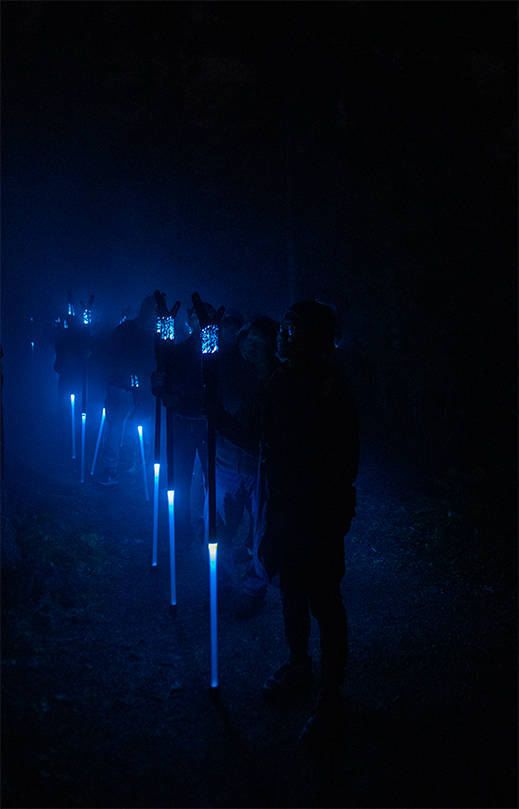 |
|
|
|
The Kamuy Lumina rhythm sticks add a few modern-day interactive features to the Y-shaped staffs that Ainu hunters would carry on expeditions to clear underbrush, vault streams, and provide protection.
Photo © Moment Factory |
At the entrance each guest receives an illuminated staff to aid navigation along the darkened paths. It is also a GPS-triggered audio device that plays bits of the story and strands of the kamuy yukar song as you move amid the trees from one stage to the next. (If you don't understand Japanese, be sure to read the leaflet -- available in English, Hangul, and simplified and traditional Chinese -- beforehand.) In the epic songs of the Ainu the calls and cries of the narrating deity often appear at the head of each line as a kind of refrain, the lyrics following after. The resulting repetition -- in this case the hunko, hunko, hunko hooting of the owl -- yields their unique cadence, a rhythm typically accompanied by dance. Days after I experienced Kamuy Lumina, the soft plaintive singing of Shitaku, preserved in a vintage recording and mixed with the voice of her granddaughter who performs in Akan today, continued to sound in my ears. This inspired bit of editing -- uniting the generations in an artistic nod to the Ainu oral tradition -- is a lovely touch to the production that you won't find mentioned in any of its official write-ups.
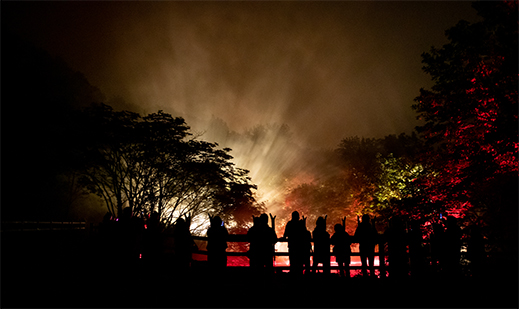 |
|
Bokke's volcanic mud pots are transformed into a roiling realm of angry gods in this section of the tale, entitled "A Warning."
Photo © Moment Factory |
If the Kamuy Lumina story arc is predictable -- it is, after all, a fable about the folly of hubris -- the effects used to render the tale are nonetheless entertaining. Projection mapping turns the trunks of actual trees into screens on which events unfold. LED lighting transforms a canopy of leaves into a fantastically pulsating threshold to the world of the gods. Beyond, the deities' rage and admonitions bellow forth in red and blue waves of laser light. Tiny koropokkur, the Ainu folklore equivalent to faeries or leprechauns, pop up here and there in the groundcover, providing comedic (if a bit overdone) relief. A scene where animated deer bound away amid a stand of trees is truly magical -- a favorite, it turns out, of nearly everyone I spoke with during my stay in town. Also to its creators' credit, the production leaves the walking trail as is -- unpaved and uneven, and crisscrossed with tree roots.
Kudos, too, for an attraction that encourages people to think about our relation with divine spirit. And while I was glad to see that shop owners at this quieter end of town will benefit from the increased pedestrian traffic (in fact this is the original heart of the resort, before the Ainu kotan, or village, was built to the west and newer hotels sprang up down the way), still my foremost thought as I exited the Bokke woods was concern for its birds and creeping inhabitants. How are frogs and toads and insects and small furry creatures coping with this nightly assault of sound and light in their habitat? For that matter, what about the trees and plants?
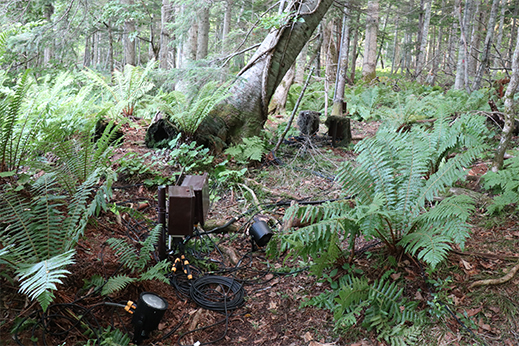 |
|
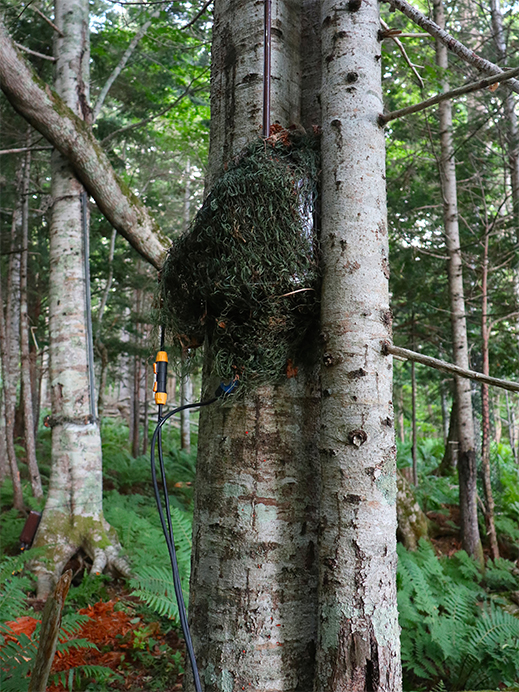 |
|
|
|
Speakers, cables, projectors, fuse boxes -- even a heavy-duty polypropylene latch-and-stack tote -- are among the current sightings in the Bokke forest, some less camouflaged than others. On an early-morning walk, the whirring sound of motorized fans mixed with birdsong. |
Three years and an investment of several hundred million yen went into the planning and installment of Kamuy Lumina. Approval was granted by Japan's Ministry of the Environment, the Forestry Agency, and the Akan-based Maeda Ippoen Foundation -- the owner of the site and an organization dedicated to the preservation of local forestland. Naturally, an ongoing environmental impact assessment is part of the project. When the show closes in November for the winter season, an independent team of specialists will return to Bokke to update their existing body of field data on its plants and wildlife. Based on their findings, any recommendations about the amount of light, volume of sound, placement of stages along the route or other issues will be reviewed and addressed before the production resumes in May or June.
Some furred, feathered, winged, and scaled inhabitants of Bokke may migrate to the deeper surrounding woods, altering its ecosystem in ways no one can predict. On the bright side, though, this new attraction sits within the only town on Lake Akan's shores -- all around is wilderness. As more visitors circulate from one end of Akan Onsen to the other, staying longer and making it a livelier place, one scenario is that the tiny hot-spring resort will thrive as a base for activities that actually support nature conservation: canoeing, cycling, hiking, trekking, and hiring of knowledgeable certified guides.
The inherent irony of presenting, as a tourist attraction, a tale about living in balance with nature is not lost on those involved. Shusei Toko, director of the Akan Ainu Industrial Arts Association and cultural advisor to the Kamuy Lumina production, acknowledged my concern. "We can't get our priorities backwards. Living in harmony with nature is the message, and the medium has to support it," he assured me. "Cautionary tales about human failings like greed, waste, and disrespect for other living things are common in our legends. Their lessons are more valid today than ever." He noted that if Ainu culture has something to offer that supports the larger Akan community through tourism, the kotan community stands behind it. Kamuy Lumina is the first of its sister productions to be created together with indigenous people. Managed conscientiously, it could become a model for other soft-adventure projects based on native communities' wisdom.
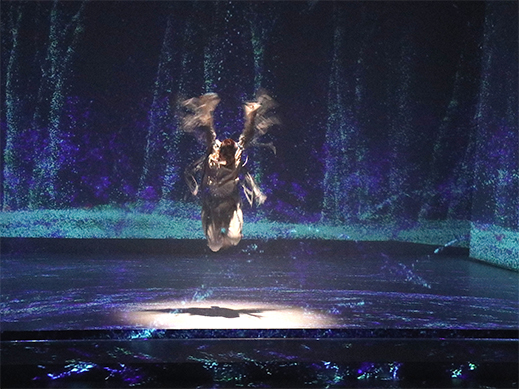 |
|
Amid the sparkling shine of tree auras, a dancer in Lost Kamuy relates the moment a wolf god takes human form. |
Toko is also stage director of Lake Akan Ainu Theater Ikor at the west end of town. His latest production is Lost Kamuy, a new Ainu tale uniting contemporary dance with ceremonial ritual and 3-D digital imagery. The work of a handpicked team of creatives in photography, sound design, choreography and visual imagery, it blends Ainu singing with recorded sounds of the forest, including rhythms measured out by the bubbling mud pots of Bokke. Performers dance to this soundscape as three-dimensional projections play across multiple screens, theater drops, and even the proscenium floor, expressing the Ainu belief that divine spirits reside throughout our surroundings, manifesting as animals, plants, fire, water and wind. "I'm often questioned about my motivations for expressing Ainu culture in digital form," Toko offered. "My only answer is 'nothing ventured, nothing gained.' Song and dance are intrinsic to Ainu culture. Digital expression is simply a tool for entertainment, for making connections."
At the end of every Ikor show audience members are invited on stage to join the cast in dance, that age-old universal celebration of life. Back in Bokke at the other end of town, a signpost erected years ago states "Renewal is the forest's strength." May birdsong, chirping insects, and the gurgling energies of Earth herself be the soundscape of my next morning strolls along its paths, affirming that life does indeed go on in the forest as well as the town.
 |
|
Combined tickets are offered for Kamuy Lumina and Lost Kamuy, two different takes on how Akan's Ainu community, the largest in Hokkaido, is preserving its cultural heritage while keeping it new. Photo © Moment Factory |
All photo permissions are courtesy of Akan Adventure Tourism Corporation. |
 |
| Kamuy Lumina |
| Daily through 10 November 2019; reopening in Spring 2020
|
| Lost Kamuy |
| Daily through 31 January 2020; check website for schedule thereafter
|
|
 |
 |
Susan Rogers Chikuba
Susan Rogers Chikuba, a Tokyo-based writer, editor and translator, has been following popular culture, architecture and design in Japan for three decades. She covers the country's travel, art, literary and culinary scenes for domestic and international publications. |
|
 |
|